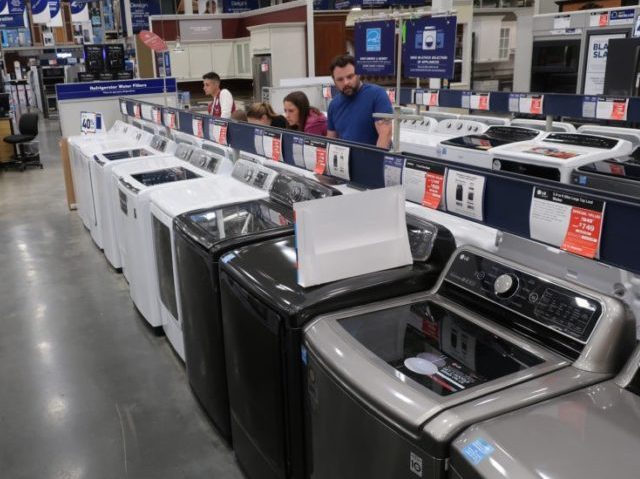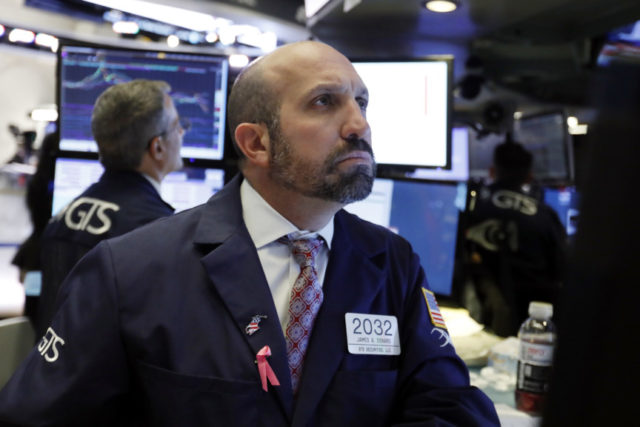https://www.breitbart.com/economy/2018/11/21/jobless-claims-jump-to-224000-much-worse-than-expected/

1:41
The number of U.S. workers filing new applications for unemployment benefits jumped 3,000 to a seasonally adjusted 224,000 in the week ended November 17, the Labor Department said Wednesday.
Initial jobless claims are a proxy for layoffs. They have been closely watched to see if the trade war might weigh on the U.S. labor market, which has been very robust for the past two years. Until recently, jobless had been at record lows. In recent weeks, however, jobless claims have been climbing.
Economists had forecast 215,000 new applications for jobless benefits last week. At 224,000 for the week, jobless claims came in above the range of estimates of economists surveyed by Bloomberg’s Econoday.
In addition to the higher than expected number for last week, the prior week was revised up from 216,000 to 221,000.
Jobless claims can be volatile from week to week, and can rise or fall due to temporary conditions such as weather and fire. The four-week moving average of claims, considered a more reliable gauge of the labor market, rose last week to 218,500. While 2,000 above the prior week’s average, that is still a low level of new claims.
Looking for a silver lining? The number of continuing unemployment benefit claims fell by 2,000 to 1,668,000 in the week ended November 10. Continuing claims are reported with a one-week lag.
Another Economic Alarm Bell: Durable Goods Drop in October

1:59
Orders for long-lasting factory goods fell in October by more than expected, declining by 4.4 percent from the previous month to a seasonally adjusted $248.52 billion.
Economists had expected a 2.6 percent decline. September was revised down to a 0.1 percent decrease from a previous estimate of a 0.7 percent increase. New orders have declined in three of the last four months.
Through the first 10 months of the year, demand for durable goods–those expected to last 3 months or more, was up 8.7 percent, compared with the same period a year earlier.
New orders for nondefense capital goods excluding aircraft, often watched as a proxy for private sector business investment, were flat in October. Economists had forecast a 0.3 percent gain. September was revised down to a drop of 0.5 percent from the prior read of a 0.1 percent decline. New orders fell 0.2 percent in August. This is up 6.4 percent in the first 10 months of this year compared with the ten-month period in the prior year.
The Trump tax reforms were intended to increase business investment and there is evidence that this was effective, at least in the first half of 2018. But the early burst of activity may have now petered-out. And the threat of tariffs may also have pushed some investment to earlier in the year.
There were some bright spots in the October report. New orders for communication equipment rose 3,2 percent. Orders for electrical appliances rose 2.9 percent. Orders for computers were up 1.6 percent. So tech manufacturing is holding up well.
Political uncertainty ahead of the November midterm elections may have played a role in the October slowdown.
Thousands of GM salaried workers to lose jobs in 2019
By Jerry White
21 November 2018
Thousands of salaried employees at General Motors in the US and Canada will be thrown out of their jobs at the beginning of 2019 as the Detroit-based automaker accelerates its cost-cutting campaign. The white-collar job cuts, which are also coming at Ford, are part of an expected blood-letting of salaried and hourly jobs amid declining sales worldwide and telltale signs of an impending restructuring of the global auto industry.
 Lordstown Assembly Complex
Lordstown Assembly Complex
GM sources told the Detroit Free Press and Detroit News that at least 3,000 employees would be terminated because not enough had agreed to “voluntary buyout” offers sent out last month. The company is targeting 17,700 salaried workers with at least 12 years’ experience or more than a third of its white-collar workforce in North America.
According to internal sources who spoke to the Detroit media outlets, GM hoped to get at least 7,000 white-collar workers to sign up for the buyout offer by noon Monday, but managers told employees late last week that only 4,000 had done so. “That means 3,000 or more salaried workers in North America could be terminated starting in January if the automaker in fact opts for forced job cuts, which it has said it would consider if buyouts fell short,” the Free Press wrote.
GM managers held staff meetings last Thursday and Friday to ratchet up pressure on salaried workers to take the deals, which include six months’ of pay and health care coverage. It is unlikely many more will opt to do so since this is exactly the same severance package for a GM employee with 12 years or more seniority who is involuntarily terminated.
According to one source who spoke to the Free Press, “GM will complete the voluntary buyouts by Nov. 29. The managers we’ve talked to are already making their list and will select their cuts in January.” On January 15, he said, GM will announce the involuntary job eliminations, and “walk people out.”
Industry analysts said the cuts targeting engineers, designers, mid-level managers and others are only a prelude to slashing thousands of production workers’ jobs. Market economist Jon Gabrielsen, an adviser to the auto industry, told the Free Press, "I absolutely still believe that 7,000 to be the salaried job reduction number for GM in metro Detroit over the course of an auto downturn in the next two to three years, plus as much as another 7,000 in hourly based on how much sales soften," he said.
The global automakers are under enormous pressure from Wall Street to increase profit margins and shareholder payouts despite falling sales. Last month, GM reported that its third-quarter operating profits in North America increased by 37 percent to $2.8 billion despite an 11 percent drop in sales during the quarter in the company’s key US market.
 Lordstown workers on last day of the second shift in June
Lordstown workers on last day of the second shift in June
In an internal memo obtained by the Free Press, which was sent out to managers after the profit announcement, GM said, "We can't confuse progress with winning. Today, our structural cost is not aligned with the market realities nor the transformational priorities ahead. We must take significant actions now while our company and the economy are strong” to “reduce structural costs and improve vehicle profitability."
While GM is planning to cut $6.5 billion in costs, it has squandered over $10 billion in stock buybacks and dividend payouts for its richest investors since 2017, and $25 billion since 2012.
Earlier this month Ford said it will reduce its salaried US workforce of 70,000 employees by an unspecified number as part of its $11 billion “fitness” cost-cutting plan. Morgan Stanley analyst Adam Jonas projected a 12 percent cut in Ford staff worldwide in a note to investors in August saying, “We do not see restructuring at Ford as a ‘nice to have’… but as a crucial step to set the global business on a more balanced footing.”
While seeking to slash jobs all of the automakers have increased the number of white-collar workers hired through temporary agencies who receive lower pay and few, if any, health care and pension benefits.
At the same time, the Detroit-based automakers have carried out temporary layoffs of production workers and permanent jobs cuts and plant closings are expected. Last month, Ford idled its Kansas City, Missouri plant, putting 2,000 workers on temporary layoff.
With sales of its Chevy Cruze compact falling, there are widespread concerns that GM may close its assembly plant in Lordstown, Ohio, halfway between Cleveland and Pittsburgh. GM laid off 1,200 workers when it eliminated the third shift at the plant last year and another 1,200 workers when the second shift ended in June.
A second-tier worker at Fiat Chrysler’s Belvidere, Illinois assembly plant told the WSWS Autoworker Newsletter that threats are being spread about the possible elimination of one shift at that facility. “A supervisor told me to start watching the Illinois.gov WARN site for them to post a 60-day notice of layoff,” the worker said, adding, “our union steward said there is a very good chance that we will be laid off December 15 for an unspecified amount of time. More and more talk of eliminating the first shift is causing people to transfer departments and shifts in hope of saving their jobs.”
Temporary layoffs have hit a number of Fiat Chrysler facilities including Belvidere Assembly and Kokomo, Indiana transmission plants.
The United Auto Workers (UAW) has not even made a pretense of opposing jobs cuts, echoing management’s claims they are necessary to ensure continued profitability in the face of slowing sales. The automakers have been able to extract huge profits in North America, despite falling sales, with the collusion of the UAW, which has signed labor agreements slashing the wages of new hires, eliminating income security for laid off workers and expanded the number of temporary part-time workers who pay union dues but have no rights and do not qualify for supplemental unemployment benefits.
The salaried and hourly job cuts are clearly a shot across the bow of autoworkers in advance of the negotiations for new labor agreements, after the current deals expire in September 2019. In 2015, the threat of plant closures and mass layoffs was used by the automakers and the UAW to ram concession deals past the opposition of workers who initially voted down a contract at Fiat Chrysler, in the first such defeat of a UAW-backed national deal in three decades.
In a letter sent to workers, UAW Vice President for GM Terry Dittes made it clear the UAW would try to blackmail workers with job threats once again. “Filling our plants with product” would be the UAW’s top priority in the 2019 contract negotiations, Dittes said, before echoing Trump’s American First nationalism by railing against GM for expanding production in Mexico and China.
This underscores the need for autoworkers to build new organizations of struggle, including factory committees, controlled by rank-and-file workers themselves and independent of the corporate-controlled UAW, to wage a collective fight against the coming attacks on jobs and living standards. Such a fight must unite workers throughout the world against the transnational auto companies and the capitalist profit system, which enriches the corporate and financial elite at the expense of workers the world over.
“They’re instilling fears about cutting a shift and eliminating anyone hired after 2011,” the Belvidere worker told the Autoworker Newsletter. “Threatening more layoffs, all tactics are to get tier-two employees to take whatever they throw at us in upcoming contract negotiations.”
The worker referred to the corruption scandal that has erupted in the UAW, which revealed how union negotiators had taken million in bribes to sign “company friendly agreements.” “The tides have shifted. The UAW is no longer on our side and they haven't been in a long time. The more these cases are exposed, the more apparent that is becoming. It’s very sad, but it’s true.”
Stocks Crushed: Dow Falls 550 Points, Retail and Tech Wrecked

1:03
The major U.S. stock indexes plummeted on Tuesday morning, giving up all of their gains for the year.
The Dow Jones Industrial Average dropped 585 points. The S&P 500 dived 2 percent. The Nasdaq Composite, heavily loaded with tech stocks, dropped 2.5 percent. All three indexes are now flat or negative for 2018.
Retail and tech stocks were some of worst performers in early trading. Target fell by more than 10 percent after reporting quarterly earnings that disappointed investors. Apple shares fell by nearly 4 percent. Google’s Alphabet shares dropped by 1.4 percent. Amazon’s were off by 2.3 percent. Twitter shares sank 3.5 percent.
Facebook shares, which have sold off sharply in recent days, actually rose a half of a percentage point in the first hour of trading.
Homebuilder Sentiment Unexpectedly Crashes to Lowest Level in Two Years

2:01
This is not a test of the emergency broadcast system. The housing market just sent up the clearest distress signal since the Federal Reserve began raising rates.
Sentiment among homebuilders dropped 8 points in November to 60 in the National Association of Home Builders/Wells Fargo Housing Market Index. Economists had expected it to remain unchanged at 68.
The November reading is the lowest since August 2016, when the economy appeared to hit an air-pocket prior to the election of Donald Trump. Last year, the index was at 69 in November and headed toward its December high point of 74.
The problem is affordability. Rising interest rates combined with high home prices have put new homes out of reach for many Americans.
The current sales component of the homebuilder’s index fell 7 points to 67. The expectations for sales compnent crashed 10 points. Buyer traffic dived 8 points to 45, deep into negative territory in the index where scores above 50 indicate expansion.
Mortgage rates have gone up a full percentage point over the last 12 months, thanks largely to the Federal Reserve’s policy of raising its overnight target and shrinking its balance sheet of government debt and government-sponsored mortgage bonds.
Homebuilding has a large impact on the economy because it employs workers in a variety of trades and new home purchases tend to drive sales of everything from home appliances to electronics and even cars.
By region, the South and West, often the harbingers of housing nationwide, were both sharply lower at 65. The Midwest and Northeast at 52 were both also sharply lower.
The index reading was so low that many wondered if it was a misprint or simply an anomaly. This week will feature an array of housing data that should clarify if the NAHB index properly read the housing market.
Consumer Sentiment Fell Following Midterm Elections

1:39
Consumer sentiment declined following the midterm election, according to the University of Michigan’s survey.
The index fell to 97.5 for the final November score, down from October’s 98.6. Economists had estimated less of a post-election impact, forecasting a reading of 98.3.
“Although the data recorded a decline of 2.8 Index points following the election, the drop was related more to income than political party: among those with incomes in the bottom third, the Sentiment Index rose by 10.4 points and fell by 6.6 points among those in the top third of the income distribution. In contrast, the Sentiment Index remained unchanged among Democrats and Republicans prior to and following the election,” the survey’s chief economist Richard Curtin said in a statement.
The current conditions component fell 8 tenths to 112.3. Expectations, were down more, 1.2 points to 88.1. That would also appear to indicate that the fallout from the election of a Democratic majority to the House of Representatives, creating a divided government, depressed consumer sentiments.
Despite the decline, the November reading os nearly at the center of the eleven-month range from 95.7 to 101.4, according to Curtin.
Notably, the volatility of the stock market in October and November does not seem to have weighed on consumer sentiment. The current reading is considered “very favorable,” Curtin said.
No comments:
Post a Comment